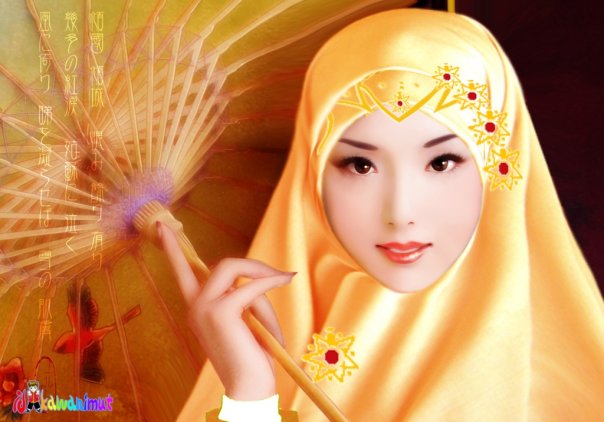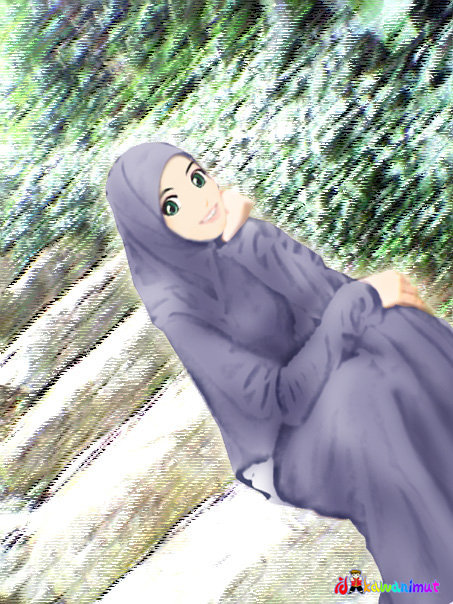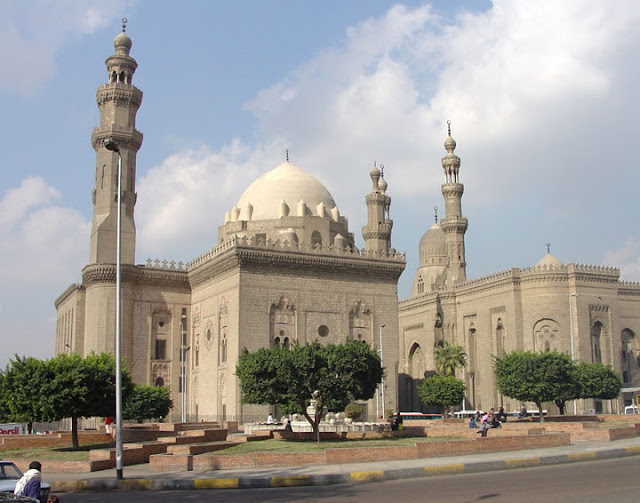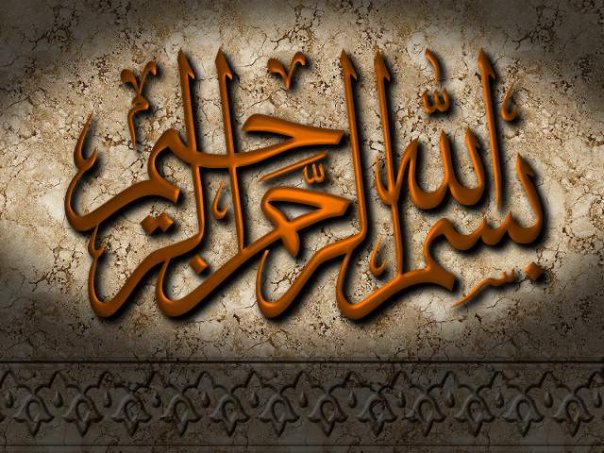Thursday, September 23, 2010
Saturday, August 28, 2010
Supernova Cloud Wallpaper
His verily is all creation and commandment. Blessed be Allah, the Lord of the Worlds ! (Qur'an 7:54)
Monday, August 9, 2010
Saturday, July 3, 2010
Friday, July 2, 2010
Islamic Wallpaper - Green Calligraphy Quran and Mosque

Islamic Wallpaper - Green Calligraphy Quran and Mosque
Thursday, July 1, 2010
Islamic Wallpaper - Night Sky With Moon and Qur'an Calligraphy

Islamic Wallpaper - Night Sky With Moon and Qur'an Calligraphy
Labels:
Al-Qur'an Wallpapers,
calligraphy,
holy month,
night,
sky
Friday, June 18, 2010
Exam Islamic Wallpapers
Exam Islamic Wallpapers

they say the higher you fall, the higher you will bounce :)
All you need is 99% hardwork and 1% or genius.
Good luck ! Break a Leg !
Don't study last minute, but study till the last minute.
YOu'll never know how high you can fly, unless you spread your wings and fly.
Work hard!do your best!
Thursday, June 17, 2010
Islamic Wallpapers- Have you heard? Palestine Wallpapers

Friday, June 11, 2010
Islamic Wallpaper Calligraphy Alhamdulillah

Friday, June 4, 2010
Islamic Wallpaper Allah AlMighty Calligraphy

Islamic Wallpaper Allah AlMighty Calligraphy
Labels:
Allah,
Almighty,
calligraphy,
golden islamic,
islamic wallpaper
Wednesday, June 2, 2010
Islamic Wallpaper Beautiful Golden Flower Calligraphy

Islamic Wallpaper Beautiful Golden Flower Calligraphy
Tuesday, June 1, 2010
Islamic Wallpaper Masjidil Aqsa

Islamic Wallpaper Green Calligraphy

Friday, May 21, 2010
Islamic Wallpapers : Solar Clipe Moon
He it that cleaveth the day-break (from the dark) : He makes the night for rest and tranquillity, and the sun and moon for the reckoning (of time) : Such is the judgment and ordering of (Him). the Exalted in Power, the omniscient (Qur'an 6:96)


Wednesday, May 5, 2010
Islamic Wallpaper Golden Flower Calligraphy Photo

Islamic Wallpaper Golden Flower Calligraphy Photo for your collection.
Labels:
calligraphy,
calligraphy photo,
flower,
Golden,
golden islamic,
islamic wallpaper
Islamic Wallpaper Purple Calligraphy Allah is Beautiful

Allah is beautiful and loves beauty.
Thursday, March 25, 2010
Give thanks to ALLAH
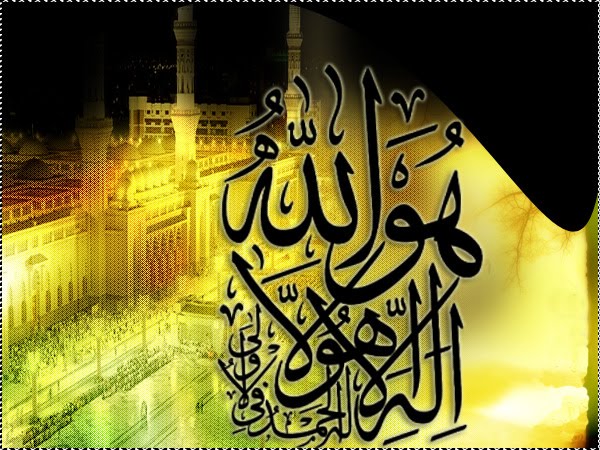
Michael Jackson reported to have converted to the Nation of Islam in December 2003. Saeed Shabazz, a reporter for the Nation of Islam’s publication, The Final Call, announced that Mr. Jackson had joined the organization. According to the publication, in 2005, he had officially announced that he has been following the five tenets of Islam and intends to convert to Islam, according to a report on the website of Arab-Israeli newspaper Panorama. Discover Islam spokesman Aman Khailb adds, “Thousands of people are embracing Islam, Michael is just one of them”.
“Give thanks to Allah
For the moon and the stars
Prays in all day full
What is and what was
Take hold of your imaan,
Dont give in to shaitaan
Oh you who believe please give thanks to Allah.
Allah-hu-Gafoor,
Allah-hu-raheem,
Allah-hu-yuhibbul-muhsineen
Wa-Khaliqunna
Wa-Raaziqunna
Wa-Huwa-alakulli-shai-in-qadeer
Allah is Gafoor,
Allah is Raheem,
Allah is the One who loves the mohsineen
He is our Creator,
He is our Sustainer
and He is the One who has power over all”.
Sunday, February 28, 2010
Regents Park Mosque London England
I always enjoy visiting Mosques during my travels. The beauty of a Mosque’s architecture is often breathtaking and the design inside it’s walls resonate tranquility.
I’ve dugg up some beautiful Masjids photos from around the world that I hope you will enjoy. I’ve tried my best to also name which country each Masjid is in
I’ve dugg up some beautiful Masjids photos from around the world that I hope you will enjoy. I’ve tried my best to also name which country each Masjid is in
Labels:
england,
mosque,
mosque in the night,
Regent Park London
Wednesday, February 24, 2010
Red Sweet Love Moslem Girl Art
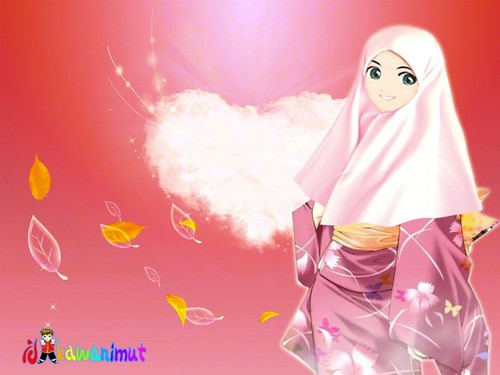
Danang Kawantoro Pictures
Labels:
effect or love,
japanese muslim girl,
red,
sweet love girl
Flower Girl Japanese Muslim
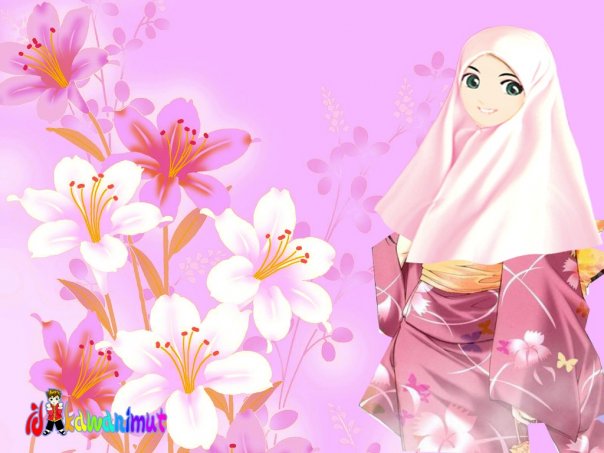
created by Danang Kawantoro
Kimono Fashion Moslem Art
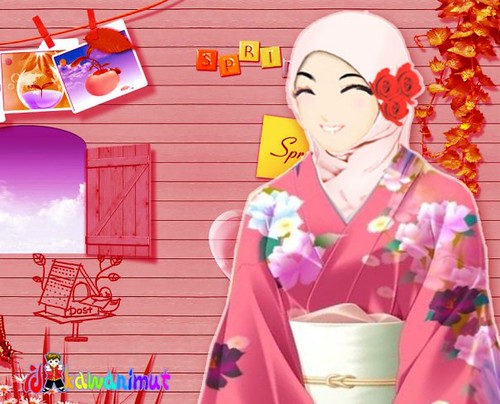
Japanese Muslim Girl for picture wallpaper islamic

Labels:
japanese muslim girl,
Muslim,
muslimah,
wallpaper islamic
Reds go Together Muslimah Pictures
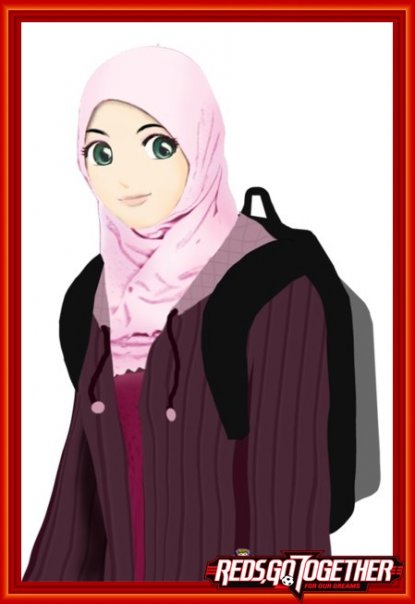
picture by Danang Kawantoro
Sunday, February 14, 2010
London Shah Jehan Mosque
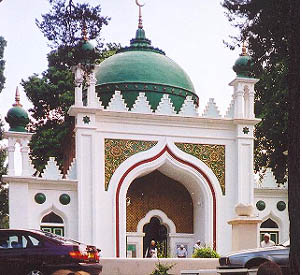
London's Shah Jehan Mosque stands tall and majestic at 149 Oriental Road, Woking, between Railway Homes and the old James Walker building. This mosque has the distinction of existing as the oldest Muslim place of worship in Britain.
Surprisingly, it was a non-Muslim who commissioned this historical treasure. Dr. Gottlieb Wilhem Leitner, a Hungarian-born scholar, acted as principal of Punjab University, Pakistan. He proved his love of knowledge by gaining fluency in Turkish, Arabic, and most European languages.
To encourage others to gain knowledge, Leitner moved to Woking and founded the Oriental Institute in 1883. Here Asian students could learn skilled professions and Europeans could prepare for lives in the Orient. To supplement the Institute, Leitner hoped to build places of worship for all major faiths, including a mosque, synagogue, church, and temple.
With the ruler of Hyderabad, India, providing financing, Leitner purchased land for the mosque. Several individuals helped with construction costs, but none more so than Begum Shah Jehan, who ruled the kingdom of Bhopal as upon the death of her mother, Sikander Begum. She also built the Taj-ul Masajid at Bhopal, one of India's largest mosques, and contributed to the establishment of the Muhammadan Anglo-Oriental College at Aligarh, which would later become the Aligarh Muslim University. A supporter of Leitner at Punjab University and became the greatest contributor for the mosque's construction, and Leitner named the mosque in her honor.
Leitner chose Victorian architect WL Chambers to design the mosque. After much quarrelling, the two agreed on a sketch based on an Indian mosque. Leitner's project used barth and Bargate stone for its construction. By 1889, the Shah Jehan Mosque was complete and open to the public.
With its domes and arches, the mosque stood out. Leitner made sure to place a fountain just outside the mosque for ablution, the washing before prayers. In addition, he constructed the Sir Salar Jang Memorial House as the residence for the Imam, the Muslim pastor.
Nearby Muslim residents, as well as students at the Institute, came to the Shah Jehan Mosque for prayers and religious holidays. Sadly, the mosque and the Institute both shut down after Leitner's death in 1899. He was unable to construct the other places of worship during his lifetime.
In 1912, Khwajal Kamal-ud-Din, a Muslim lawyer and scholar, revived the mosque. The following year, the Shah Jehan Mosque reopened as a place of worship and as the headquarters for the Woking Muslim Mission, under Kamal-ud-Din's leadership.
Shah Jehan Mosque
The mosque became the center of Islam in Britain. Members of nobility, such as Lord Headley, converted to Islam and another member and convert, Marmaduke Pickthall, published the first English translation of the Quran by a Muslim. The mosque also enjoyed visits from world leaders, such as the Shah of Persia and then-Prince Faisal of Saudia Arabia. In 1965, the Mission ceased to exist and the Mosque's control went to Sunni Muslims.
Today the mosque is still under Sunni control, and has the honor of being listed as a historical Grade 11 building. Since 1995, the local community has renovated the mosque and restored its original beauty. From the outside, the mosque amazes today's visitors with its huge blue-and-gold, crescent-topped dome. A smaller dome stands at each end, with a triangular design between them. Intricate flowers surround the entrance and geometric shapes cover the door.
A mosaic pavement with a fountain leads to the door. Today the fountain only adorns the mosque, since a separate facility exists for ablution. Another new addition to the mosque, the garden, leads visitors to the south entrance. The garden forms a hexagonal shape, with a walkway in the center. Plans are underway to turn the garden into an enclosed sanctuary.
Inside the mosque, verses of the Quran decorate the walls and the mihraab, where the Imam leads prayers. Arabic calligraphy also adorns the ceiling in a circle surrounding the central chandelier. Minarets support and add beauty to the mosque.
The mosque welcomes visitors, young and old, to the historical site and its new facilities. Tourists are asked not to visit on Fridays during prayer time (usually 1-2 p.m.).
source: http://www.timetravel-britain.com/articles/london/mosque.shtml
Eyup Sultan Mosque and Mausoleum - Istanbul
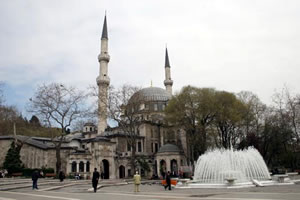
The Mosque and Mausoleum of Eyup Sultan, located outside the corner where the land walls meet the walls along the Golden Horn, is considered a sacred site for Moslems. Eyup-el-Ensari was a standard-bearer of Mohammed and he died-here during an Arabic siege of the city in the 7th century. His grave was discovered at the conquest and later the mausoleum and the first mosque in Istanbul were built on this site. The original mosque was destroyed in an earthquake and the present one was constructed in its place in 1800. On Fridays, holy days for Islam, throngs of the faithful visit the mausoleum. The old trees, flocks of pigeons, the praying believers and the visiting crowds create a mystical and colorful atmosphere around the mosque and the mausoleum. The walls of the mausoleum in the courtyard are covered with tiles from different periods.
Eyup Sultan MausoleumHistorical sources indicate that in Byzantine times this district was also a holy site where people came to visit the grave of a saint and to pray for rain during times of drought.
The sultans succeeding Mehmet the Conqueror completed their coronation and sword-bearing ceremonies with a visit to the Eyup Sultan Mausoleum.
The vicinity of the Eyup Sultan Mosque and the neighboring hills are occupied by cemeteries. The famous Pierre Loti Cafe is also in this district. The well-known poet and author Loti was enraptured by Istanbul and he came here often to watch the beauties of the Golden Horn of those days. The view from this small cafe and the terrace, particularly during full moon, leaves long-lasting impressions on the visitors.
source: http://mosques.inistanbul.com
Dolmabahce Mosque is located in the south of Dolmabahce Palace,in Besiktas, on the European coast of Bosphorus
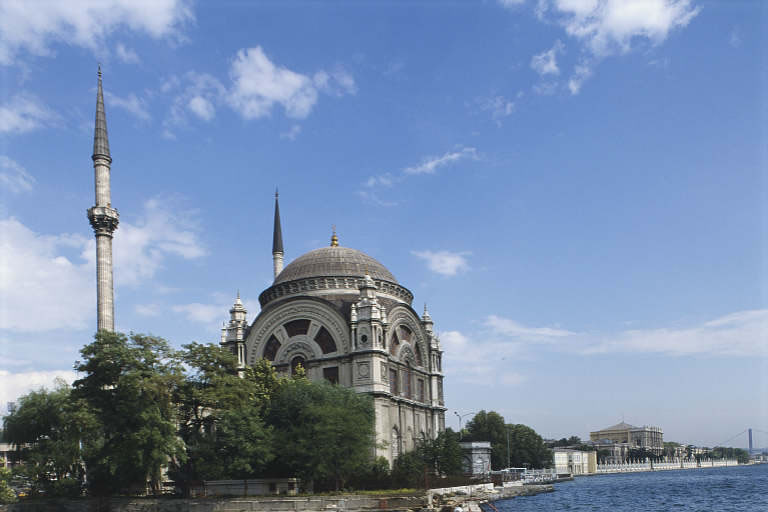
Dolmabahce Mosque is located in the south of Dolmabahce Palace,in Besiktas, on the European coast of Bosphorus. It was originally commissioned by the mother of Sultan Abdulmecid, Bezm-i Alem Valide Sultan, but on her death it was continued by Sultan Abdulmecid. The mosque was completed in 1855; its architect is Garabet Balyan,who is also the architect of Dolmabahce Palace and Dolmabahce Clock Tower.
Dolmabahce Mosque
Dolmabahce Mosque is one of the ornamented mosques constructed in Baroque style in Istanbul. Since the mosque is adjacent to the palace, a two storey Sultan maksoorah was constructed on the front part where the Sultan and statesmen can perform their prayers and where public processions and meetings could be accommodated. Circular window design which is rarely seen in our mosque architecture gives the building a different look with its peacock-tail design.
Dolmabahce Mosque has two minarets with a single balcony. The interior has a decoration having a mixture of baroque and ampere styles. From the dome hangs a precious chandelier. Mihrab and mimbar is made of red porphyry.
Source: http://mosques.inistanbul.com
Saturday, February 13, 2010
The new Sheikh Zayed mosque in Abu Dhabi

The new Sheikh Zayed mosque in Abu Dhabi will be the biggest mosque in the United Arab Emirates and the third largest in the world
Labels:
abu dhabi mosque,
largest mosques,
mosque,
sheikh zayed mosque
Grand Husseini Mosque, Amman
A short stroll through the throbbing streets of the heart of downtown Amman and the glittering famous gold souq is The Grand Husseini Mosque.
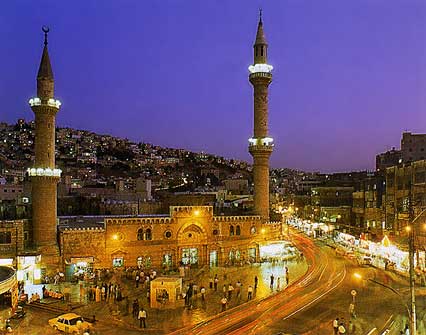 This Ottoman style mosque was rebuilt using striking pink-and-white stone in 1924 by the late King Abdullah I on the site of an ancient mosque built originally in 640 AD by Omar ibn Al-Khattab the 2nd Caliph of Islam.. Probably also, the site of the Cathedral of Philadelphia.
This Ottoman style mosque was rebuilt using striking pink-and-white stone in 1924 by the late King Abdullah I on the site of an ancient mosque built originally in 640 AD by Omar ibn Al-Khattab the 2nd Caliph of Islam.. Probably also, the site of the Cathedral of Philadelphia.

Labels:
Abdullah,
grand husseini mosque,
mosque,
ottoman style
The Shah Faisal Islamabad Pakistan the largest mosques in the world
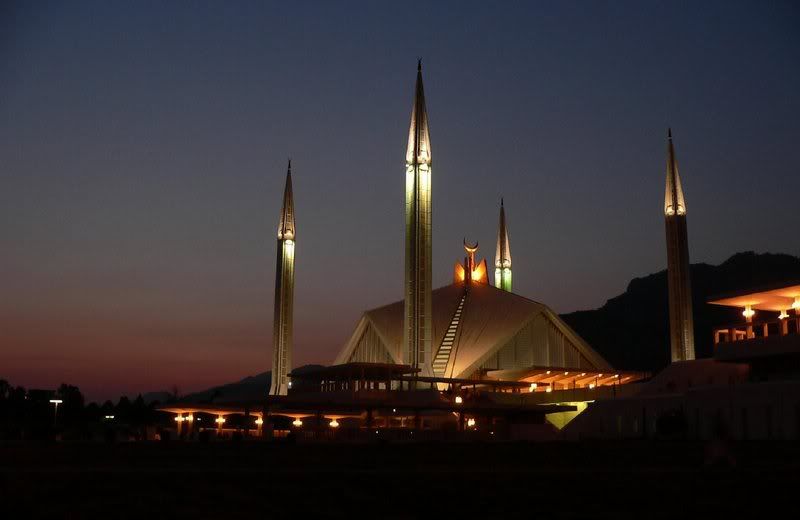
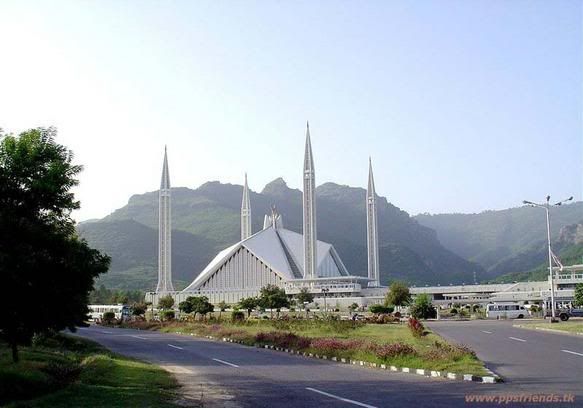
Thursday, February 11, 2010
Istanbul Suleiman Mosque
The Suleiman Mosque (Turkish: Suleymaniye Camii) is a grand 16th-century mosque in Istanbul, Turkey built by Suleiman the Magnificent.
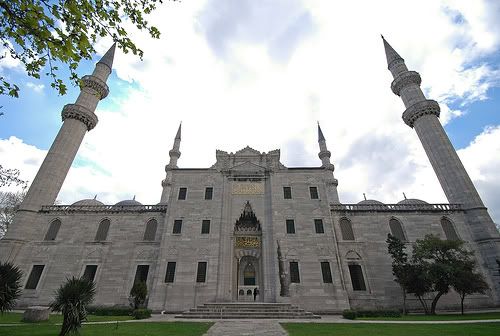
The Suleiman Mosque was built on the order of sultan Suleiman the Magnificent and constructed by the great Ottoman architect Sinan. The construction work began in 1550 and the mosque was finished in 1557.
The main entrance of the mosque is in Beyazit next to the garden of Istanbul University.
Suleiman Mosque
The mosque is modeled in part on the style of a Byzantine basilica, particularly the Hagia Sophiawhich is situated in Sultanahmet Square, which was perhaps a conscious move on the part of the sultan to create a continuity and a symbolic connection with Istanbul's past.
The Suleiman Mosque was ravaged by a fire in 1660 and was restored on the command of sultan Mehmed IV by architect Fossati. The restoration, however, changed the mosque into a more baroque style, damaging the great work severely.
Once Turkish and Islamic Arts Museum was situated in the complex of Suleymaniye Mosque,but in 1983 Turkish and Islamic Arts Museum was moved into Ibrahim Pasa Palace,in Sultanahmet.
Suleiman Mosque
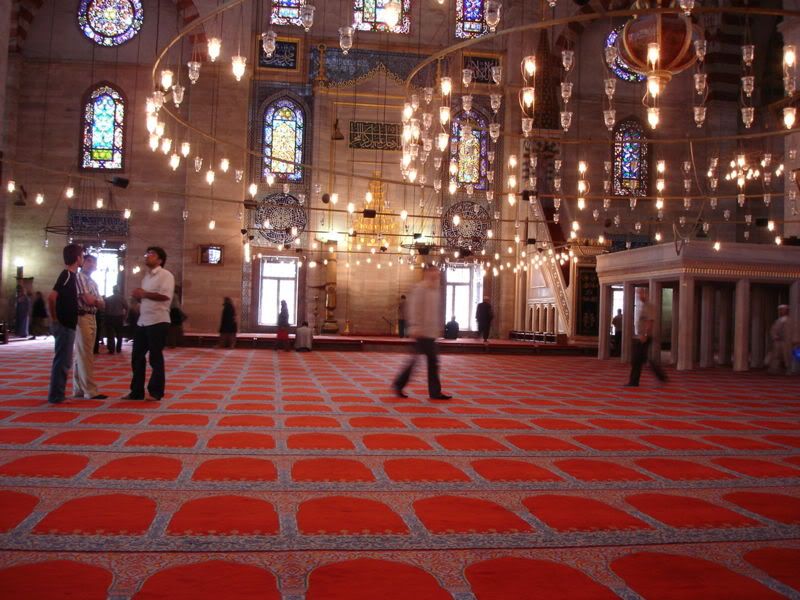
The mosque was restored to its original glory during the 19th century but during World War I the courtyard was used as a weapons depot and when some of the ammunition ignited, the mosque suffered another fire. Not until 1956 was it restored again. Today, the Suleiman Mosque is one of the most popular sights in Istanbul.
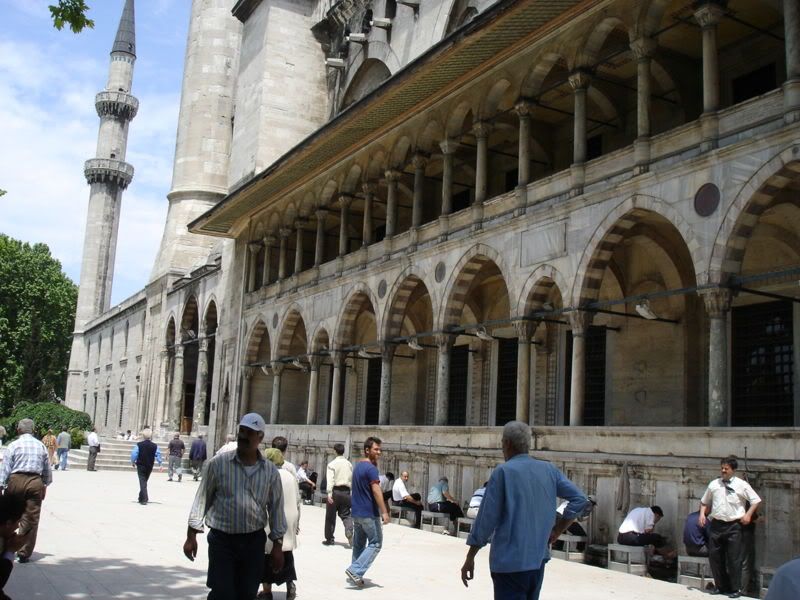
Source: http://www.pointsfromturkey.com

The Suleiman Mosque was built on the order of sultan Suleiman the Magnificent and constructed by the great Ottoman architect Sinan. The construction work began in 1550 and the mosque was finished in 1557.
The main entrance of the mosque is in Beyazit next to the garden of Istanbul University.
Suleiman Mosque
The mosque is modeled in part on the style of a Byzantine basilica, particularly the Hagia Sophiawhich is situated in Sultanahmet Square, which was perhaps a conscious move on the part of the sultan to create a continuity and a symbolic connection with Istanbul's past.
The Suleiman Mosque was ravaged by a fire in 1660 and was restored on the command of sultan Mehmed IV by architect Fossati. The restoration, however, changed the mosque into a more baroque style, damaging the great work severely.
Once Turkish and Islamic Arts Museum was situated in the complex of Suleymaniye Mosque,but in 1983 Turkish and Islamic Arts Museum was moved into Ibrahim Pasa Palace,in Sultanahmet.
Suleiman Mosque

The mosque was restored to its original glory during the 19th century but during World War I the courtyard was used as a weapons depot and when some of the ammunition ignited, the mosque suffered another fire. Not until 1956 was it restored again. Today, the Suleiman Mosque is one of the most popular sights in Istanbul.

Source: http://www.pointsfromturkey.com
Blue Mosque Sultanahmet Istanbul Turkey
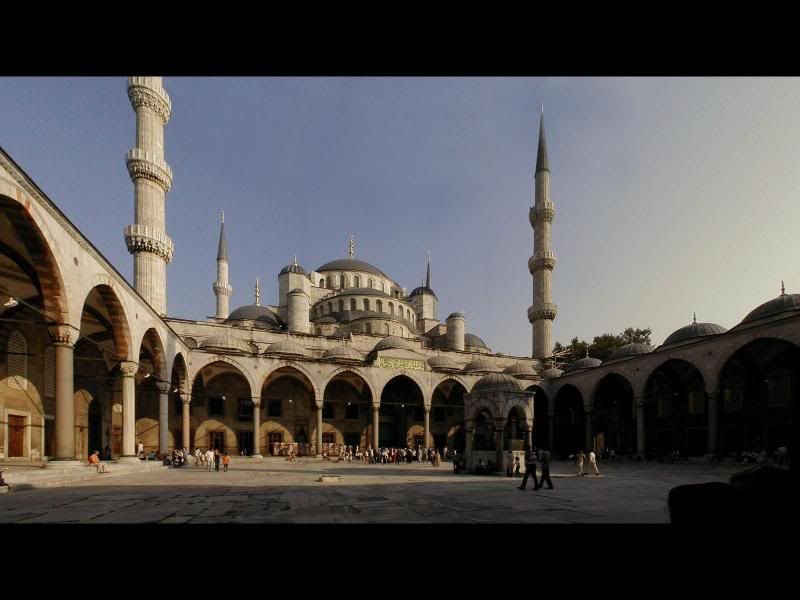
The Blue Mosque,which is one of the Istanbul's premier sights, has been constructed between the years 1609-1616 by Mehmet Aga who was one of the famous architects of the period.The location of the mosque is just opposite of the splendid Hagia Sophia as it is trying to compete with it. That is actually true because Architect Mehmed wanted to construct a bigger dome then Hagia Sophia's but he could not succeed. Instead, he made the mosque splendid by the perfect proportion of domes and semidomes as well as the splendid minarets. There is an interesting story of the mosque; according to it, Sultan Ahmet I wanted to have a minaret made of gold which is "altin" in Turkish. The architect misunderstood him as "alti" which means "six" in English. However, when the architect was shivering as "am I going to be beheaded?", the Sultan Ahmed I liked the minarets so much. Prior to that time, no sultan had a mosque with 6 minarets.The Sultanahmet Mosque is the only mosque in Turkey that has six minarets. When the number of minarets was revealed, the Sultan was criticized for presumption, since this was, at the time, the same number as at the mosque of the Ka'aba in Mecca. He overcame this problem by paying for a seventh minaret at the Mecca mosque.
Blue Mosque

The mosque , originally called “I. Sultan Ahmet Mosque” is situated in Hippodrome at the Sultanahmet Square where important Byzantine buildings stand too. The mosque complex includes a bazaar, bath and caravanserai. The Main Entrance of the Sultanahmet Mosque is on the side where the Hippodrome from the Roman Empire time stands. There are beautiful marble steps right in the middle of the courtyard, leading to the main courtyard. The marble courtyard is lovely, its marble comes from the Island of Marmara (the Turkish word for marble ,"Mermer" comes from Marmara). The mosque comprises four semidomes and a dome with a height of 43 meters supported by four pillars. The inner part is reached through three portals from the courtyard in the north of the mosque. The interior of the building is decorated with 20.143 tulips, hyacinths, carnations and ivy's. The mosque is also called “Blue Mosque” due to the blue tiles used in the interior decoration of the mosque. During the restoration works of the tiles dark blue colour was used instead of the original light blue colour. On the west side of the mihrab in front of the main entrance there stands the marble pulpit. The mausoleum of Sultan Ahmet is situated to the north and the bazaar of the complex to the east of the building. The mosque is the only mosque having six minarets. Today in the park in front of the Sultanahmet Mosque several light and sound shows are displayed during summer and Ramadan.
The cube is topped by an ascending system of domes and semi-domes, culminating in the central dome, which is 33 meters in diameter and 43 meters high at its central point. The overall effect is one of perfect visual harmony, leading the eye up to the peak of the dome.
At its lower levels the interior of the mosque is lined with more than 20,000 handmade ceramic tiles, made at Iznik (the ancient Nicaea). Its upper levels are painted. More than 200 stained glass windows with intricate designs admit natural light, today assisted by chandeliers. On the chandeliers, ostrich eggs are found that were meant to avoid cobwebs inside the mosque by repelling spiders. The decorations include verses from the Qur'an, many of them made by Seyyid Kasim Gubari, regarded as the greatest calligrapher of his time. The floors are covered with carpets, which are donated by faithful people and are regularly replaced as they become worn out.
Blue Mosque
The most important element in the interior of the mosque is the mihrab, which is made of finely carved and sculptured marble, the adjacent walls sheathed in ceramic tiles. To the right of the mihrab is the minber, or pulpit, where the Imam stands when he is delivering his sermon at the time of noon prayer on Fridays or on holy days. The mosque has been designed so that even when it is at its most crowded, everyone in the mosque can see and hear the Imam.
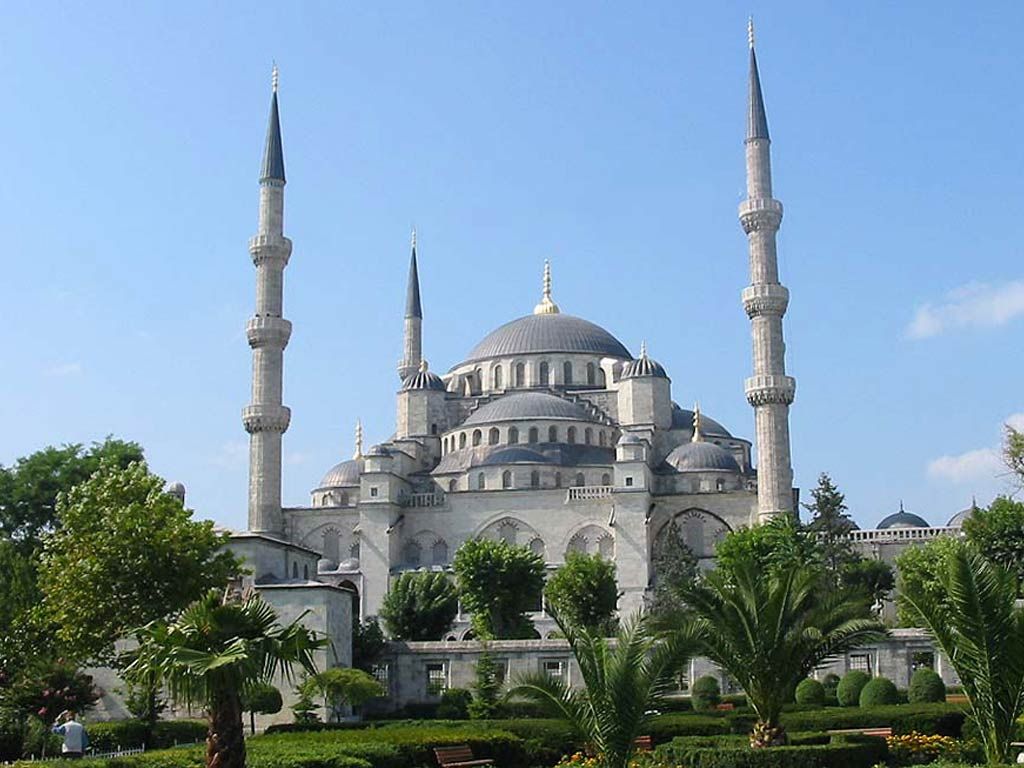
Each of the minarets has three balconies, and until recently the muezzin or prayer-caller had to climb a narrow spiral staircase five times a day to announce the call to prayer. Today a public address system is used, and the call can be heard across the old part of the city, echoed by other mosques in the vicinity. Large crowds of both Turks and tourists in Sultanahmet gather at sunset in the park facing the mosque to hear the call to evening prayers, as the sun sets and the mosque is brilliantly illuminated by colored floodlights.
Source: http://www.pointsfromturkey.com http://www.guideistanbul.net
Nuruosmaniye Mosque Istanbul

The construction of the Nuruosmaniye Mosque was started by Sultan Mahmud I in 1748 and completed by Sultan Osman III in 1755.It is situated on the European side of Istanbul,in Eminonu district,between Sultanahmet and Cemberlitas. It's a typical Baroque and Rococo style mosque which was a very popular architecture of 1700's within the Ottoman Empire. The mosque was built on one of the seven hills of Istanbul by a Greek minority architect named Simeon and Mustafa Aga.
The mosque has a semi-circular courtyard with no fountain for the ablutions but only taps today. There are two minarets each having two balconies. It has a single dome and no column within the prayer hall but raised on four large arches, having a diameter of 25 meters (82 feet) and the height of 43 meters (141 feet). There are many ornaments on its main walls, stone crescent on the minaret tops, stone work of the niche (Mihrab) and the pulpit (Minbar). On the east corner of the prayer hall there is the sultan's lodge with latticework between its columns, accessed by a ramp outside the mosque. The existence of many windows provide lots of light but also justifying the name of the mosque: Nuruosmaniye means "The Light of Osman". It also gave its name to the neighborhood.
Nuruosmaniye Mosque
The Nuruosmaniye Complex has a manuscript library as well with thousands of volumes containing also collections belonging to the sultans. This section is closed to the public except researchers with special permission. In the complex, there is also a medresse and a soup kitchen to the north, a mausoleum where Sultan Osman III's mother (Sehsuvar Valide Sultan) is buried, and a public fountain.
Somalis in UK are intending to set up a mosque
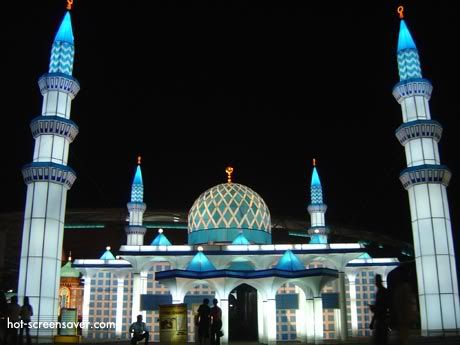
Somalis in western London are setting uo a mosque by the name Darres-salam after a charity raise in that town,this is a remarkable progress attained by the somalis in London.
Sharmake Yussuf the head of the new mosque told BBC somali service that they spent 1,725,000 to buy a plot in which the new mosque would be set up.
Sharmake says the fund raising during the holly month of ramadhan has not been concluded but he said soamlis in UK have contributed alot.
He said that 1,060,000 are now in hand for the contruction and the somalis played a bigger part .
Wednesday, February 10, 2010
Blue Mosque, Istanbul Turki

Istanbul is a wonderful city and the only one that is divided over 2 continents, as the Bosphorus separates Asia from Europe. Most of the old city is in the European part and definatly worth a visit. The Topkapi museum, the Aya Sofia and the many huge Mosques are impressive, but also the spice Bazar and grand Bazar are the perfect places to realize that here 2 world cultures merge. Do not forget to eat a cheap fresh caught and grilled fish in the harbour
The Blue Mosque was nicknamed so due to the many beautiful blue mosaic tiles, though not much can be seen on this view. Entrance is free and though the Mosque is in use as a prayer room, also non-muslims are welcome and photos can be taken.
The city is a mix of modern western shops and clothing with traditional eastern culture. The sound of the calls for prayers in the morning makes you realize that Islam is the main religion here, though for me the sounds are just as curious as the Christian bells that wake me up elswhere in the world :-)
Wallpaper Devotion to Allah

"And mention the name of your Lord and devote yourself to Him with a complete devotion" (73:8)
lavender=devotion
to give all of something especially your time,effect or love,or yourself, to something you believe in(Cambridge Advanced Learner Dictionary)
Labels:
Advanced,
Allah,
cambridge,
Devotion,
Dictionary,
effect or love,
Learner,
lord
Sunday, January 31, 2010
Subscribe to:
Comments (Atom)






